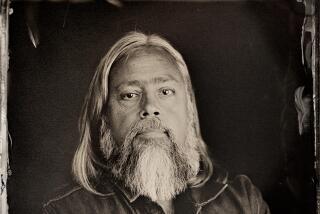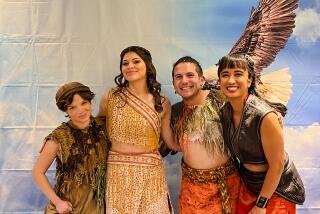Indian Storyteller Reaches for a New Generation : Culture: Larry Littlebird brings the tales and songs of his heritage to Pueblo children who have been reared on TV and Ninja Turtles.
- Share via
SANTA CLARA PUEBLO, N.M. — More than 20 years had passed since Larry Littlebird had performed at this ancient Pueblo village in the southern Rockies.
Back then he had a small part in a second-rate Western called “Flap,” starring Anthony Quinn, and was shuffled around and told how to act like an Indian to fit the story.
“It was so horrible . . . no real appreciation or understanding of what Indian people are about,” he said. “The total hokeyness of Hollywood.”
Now Littlebird, 52, has come back to tell his own tales. He is a storyteller, sharing his knowledge of the oral tradition that for millennia was the way tribal Indians, who had no written languages, imparted communal values.
They are the stories and songs Littlebird heard from his elders in community gatherings at Laguna Pueblo, west of Albuquerque; the gatherings called hama-ha that he saw all but vanish in the flick of a switch.
“One day there was no electricity, and the next day there was electricity. All the social forms of community activity just changed overnight,” Littlebird said. “As soon as television came in, you could forget any kind of the old family scene.
“I guess I was among the last to see that as a regular thing,” said Littlebird, who turned to storytelling after many years as a writer, artist and filmmaker.
The boom in American Indian literature over the last few decades helped capture much of the spirit of the oral tradition.
But the oldest stories, songs and prayers are rooted in the sway of sound, coming as they do from languages that were carried only on the wind, never written, and they take on a special sensibility when spoken or sung.
“It’s not about memory; it’s about connection,” Littlebird said as he prepared to address the children.
“The word is what we hold precious. It is the closest expression to creation. . . . You find yourself becoming older, and it’s just what you have to pass on,” he added.
It was no small task for Littlebird to make a connection with the Santa Clara children, about 100 giggling, fidgeting students from the village elementary school.
They are the third generation of TV kids, fed on Ninja Turtles and the like, with ever-thinning threads linking them to the oral traditions of the past.
But, then, the Santa Clara children know something of art well presented; they are the children of some of the finest artisans in America, whose pieces of pottery, blackened by the smoke of dung and marked by relief designs, sell for hundreds of dollars in tony shops down the road in Santa Fe.
Littlebird, an aptly titled elfish man with a resonant, soft tenor voice, begins by telling the children about the importance of listening.
It is an essential tenet of his group of storytellers, learned from tribal elders, masters of the tale.
In Littlebird’s youth, audience preparation took no more than a few words: “Hush, little ones, our elder is speaking now.”
But he employs a little modern-day cajoling, such as telling the children they are at the stage of life when they listen best, before becoming know-it-alls like the older kids.
And then, with a few preface beats on a little drum he has had since beginning his performing career at a pueblo chicken house as a youngster, he is off into a story.
It begins with the creator of all things calling the animals to assemble in the morning to get their names.
We immediately turn to the central character, who wages a long and amusing battle to stay awake in order to get the first, best name. But he eventually falls asleep.
He ends up with the last of the names: coyote.
A beguiling character of Indian lore has come to life again.
Next Littlebird tells of a jack rabbit who would not stop singing even as he is torn limb from limb by other animals trying to silence him.
The tale is punctuated with the short song of the jack rabbit, “Ya-na-ho-oh. Ya-na-ho-oh. Ya-na-ha-ha-yo.”
Each refrain from the diminishing rabbit brings more laughter from the children.
And then comes another sound, and a quieting among the children as Littlebird sings a low, haunting lullaby from winter buffalo ceremonies.
The song is in Keres, one of several languages spoken by the Pueblo, which many--probably most--of the children do not understand. But they are attentive, some of their heads tilted, their faces marked with wonder.
And then the hour is over.
Littlebird stands momentarily alone, watching the children leave, perhaps wondering if he has made a connection.
As he gets ready to leave in his truck, some of the children file by on their way to class.
And then the reviews start coming in.
“I loved the jack rabbit. I loved the song. I loved the coyote,” the children call out.
Larry Littlebird smiles.
Santa Clara Pueblo is a good setting for an Indian story after all.
More to Read
Sign up for Essential California
The most important California stories and recommendations in your inbox every morning.
You may occasionally receive promotional content from the Los Angeles Times.










